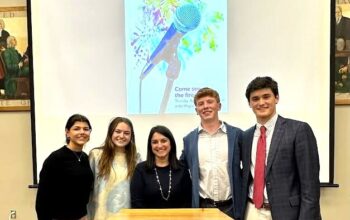Julia Hardy
Arts, Entertainment & Technology Editor
Get ready, old sport, because the movie “The Great Gatsby” opens May 10 after almost a year of build-up. While the movie follows the story line from the novel by F. Scott Fitzgerald, director Baz Luhrmann has made The Great Gatsby modern and unique. From changes in the music and fashion to more drama in the party scenes, modernizing the world of Gatsby could as easily be called a path to inaccuracy as a fresh outlook. So do these updates help Luhrmann’s vision or destroy Fitzgerald’s?

The Music
The preview to the movie alone features the songs “No Church for the Wild” by Kanye West & Jay-Z, “Bedroom Hymes” by Florence and the Machines and even a “Love is Blindness” cover by Jack White. So where’s the authentic 1920s jazz music? Luhrmann has said in a press release that using hip-hop as the source of the soundtrack is intended to give the audience “the same level of excitement and pop-cultural immediacy toward the world that Fitzgerald did for his audience [with jazz].” To accomplish this goal, he named Jay-Z the executive producer of the film as well as the overseer of the soundtrack.
According to history department chair Richard Webb, who will be in a Gatsby documentary airing in Dec from his theory that the book’s setting was based off Westport, believes that the modern music is being used to appeal to the current generation of viewers with an inability to focus. “With so much available for this generation for entertainment, they’re not going to hold the attention span of the audience when the number one form of music is hip-hop,” he said. “Just having a movie about white people in the 1920s isn’t going to appeal to the kid in the City.”
The Fashion

With costume design led by a “Moulin Rouge!” designer in collaboration with Prada, Gatsby fashion is nothing short of over-the-top. Quintessential ‘20s fashion such as flapper dresses layered with fringe, beading and vivid colors are more than abundant in the movie. But, they have been purposefully altered to have a modern twist; a group of flappers in the movie wear outfits that are more like bikinis than dresses, a style that was unseen at the time.
Besides intentional changes to make the fashion more modern, “The Great Gatsby” film also has unintentional historical inaccuracies that the average viewer wouldn’t pick up on. However, senior Isabelle Herde, a Gatsby enthusiast, did. “The preview is filled with flapper dresses with dropped waists, but these didn’t exist in the early ‘20s when The Great Gatsby was written,” she said. “They’re using them to help people who don’t really know the 1920s have a recognizable trait to associate with.”

The Party Scenes
Fireworks, streamers and giant champagne bottles fill the many lavish party scenes frequently held at Gatsby’s house. Spotlights illuminate the entire mansion and there’s a zebra swimming in the pool. In one scene, the floor is covered with what appear to be gold coins.
According to junior English teacher Kristen Brown, the flashiness of the movie is intended to compensate for the lack of space to develop the characters. “The parties will probably clarify the major ideas such as the wealth of the characters and the length that characters, particularly Gatsby, will go to achieve their goals,” she said. “There isn’t as much length or space to unfold the characters so overdoing it makes sure the message comes across.”
Mr. Webb has a different theory. “So called ‘historical films’ don’t accurately portray the time period they are set in but the time in which they are made,” he said. “It’s no coincidence that they suddenly decided to make a film about the wealthy after the 2008 economic crash. My guess is that the parties make the rich look idiotic and frivolous, and there’s probably even an anti-capitalist bent, because of what’s happening now.”
The Symbols

Despite so many changes, one important consistency is the continued use of the color symbolism that Fitzgerald created to add meaning to the decadence. The movie posters and trailers highlight these symbols. One trailer ends with Jay Gatsby reaching longingly towards the green light, which represents the American Dream, shining across the bay.
For Ms. Brown, the biggest concern is whether this symbolism will translate when the audience won’t be able to read Fitzgerald’s language. “The symbolism further drives the idea that the American Dream is forever out of reach, but I fear that the film will focus more on the plot than the symbols or language,” she said. “What makes the book so wonderful is Fitzgerald’s delicious word choice. It will be interesting to see how they translate his beautifully phrasing.”
Overall Opinion
“The problem with most films adapted from books is that you watch it and say ‘that’s not the book I read’ because while you’re reading you fill in the images,” Mr. Webb said. “But movies are a completely erroneous depiction of art because the intent is to park fannies into seats, so they sensationalize the plot line.”
httpv://www.youtube.com/watch?v=4w8lohkQtbY&feature=player_embedded



